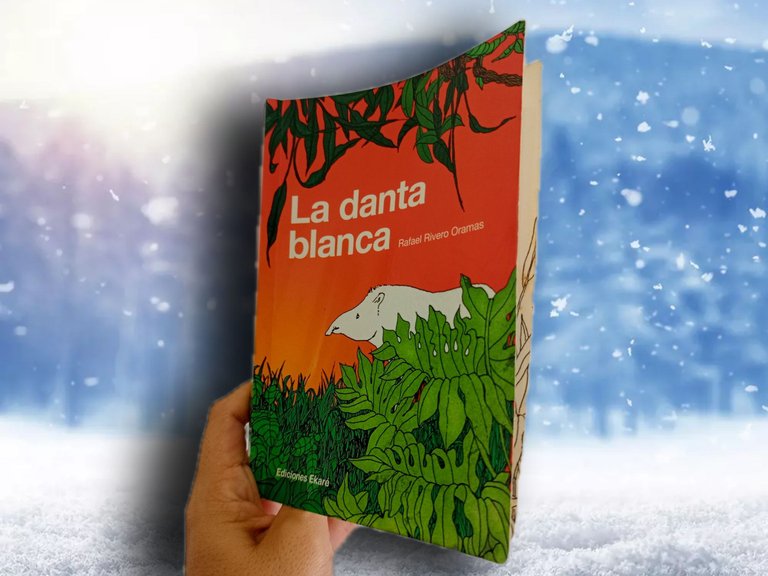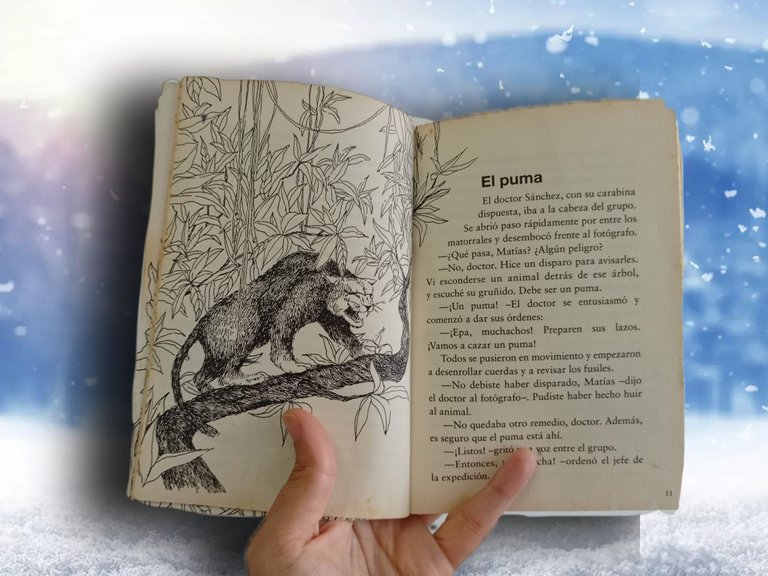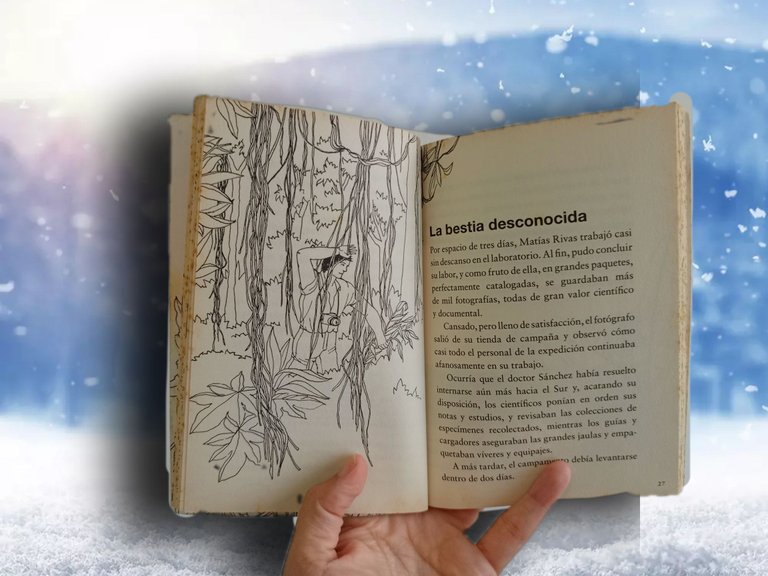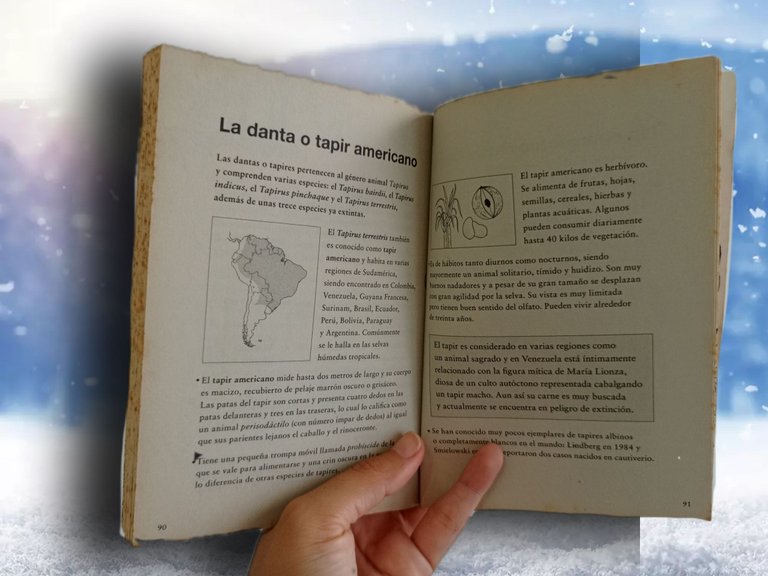Today I wanted to take a look at the novel The white tapir by Rafael Rivero Oramas, which is classified as children's literature. However, its scientific references about the flora and fauna present in the jungle area of Guayana give it scientific value. This work is divided into 17 chapters with specific names or, as mentioned by its author, by adventures.
This book also features illustrations that capture the most outstanding features and scenes of the story. The drawings are in black and white because the designer Laura Liberatote used graphite and the "plot" technique. Likewise, both animals and plants are identified, which allows a more intimate approach to the story.

The illustrations contribute to the understanding of Rivero Oramas' proposal because it can be somewhat complex to advance in the reading without having an idea of what a tapir is and the possibility of finding an albino specimen in Venezuela.
In the story, the protagonist is a photographer named Matías Rivas, who is part of Doctor Sánchez's expedition. The group also includes Macario, one of the guides, an old hunter and connoisseur of the lands located south of the Orinoco. There are also several specialists, among them an ornithologist and a botanist. The purpose of the expedition is to find new and rare specimens in the jungle in order to capture them and bring them to the city.

The strange disappearance in the camp of a tapir, which was taken from its cage without authorization, puts the men on alert, especially the photographer who begins to investigate. After analyzing the details of what happened, he concludes that someone outside the expedition took the animal. Days later, the photographer goes into the jungle and manages to identify tapir tracks, his interest was such that he got lost in the bowels of that green labyrinth.
After tracking the tracks for a long time, he spots an albino tapir, a great discovery for the scientific world. But his surprise is great when he also finds Andres, a mestizo raised in an indigenous tribe and who was responsible for committing the robbery in the camp.

For the realization of this novel, the author consulted different bibliographies, among them; glossary of indigenous voices, books on botany, geography, fauna and common plants in Venezuela, which reflects his concern to shape the work through real references.
At the end of the book, we can find an informative appendix, where we are offered details and characteristics of the tapir or Amazon tapir, an animal whose presence in its habitat has decreased dramatically in the last 30 years. For this reason, it is currently in danger of extinction due to the rise of mining and indiscriminate hunting, since both its skin and meat are very valuable, especially for the indigenous tribes of the region.

Hoy quise dar una mirada a la novela La danta blanca de Rafael Rivero Oramas, la cual está catalogada como literatura infantil. Sin embargo, sus referencias científicas sobre la flora y la fauna presente en la zona selvática de Guayana le conceden valor científico. Esta obra está dividida en 17 capítulos con nombres específicos o, como lo menciona su autor, por aventuras.
En este libro también se distinguen ilustraciones que captan las características y escenas más resaltantes de la historia. Los dibujos están en blanco y negro debido a que la diseñadora Laura Liberatote utilizó grafito y la técnica "trama". Así mismo, tanto animales como plantas son identificados, lo que permite un acercamiento más íntimo a la historia.

Las ilustraciones contribuyen a comprender la propuesta de Rivero Oramas porque puede resultar un tanto complejo avanzar en la lectura sin tener una idea de qué es una danta y la posibilidad de hallar un ejemplar albino en Venezuela.
En la historia, el protagonista es un fotógrafo de nombre Matías Rivas, quien forma parte de la expedición del Doctor Sánchez. En el grupo también está Macario, uno de los guías, un viejo cazador y conocedor de las tierras ubicadas al sur del Orinoco. Además viajan varios especialistas, entre ellos un ornitólogo y un botánico. El fin de la expedición es hallar nuevos y raros especímenes en la selva para capturarlos y llevarlos a la ciudad.

La extraña desaparición en el campamento de una danta, misma que fue extraída de su jaula sin autorización, pone en alerta a los hombres, en especial al fotógrafo que empieza a investigar. Después de analizar detalles de lo ocurrido, concluye que alguien ajeno a la expedición se llevó al animal. Días después, el fotógrafo se interna en la selva y logra identificar huellas de danta, su interés fue tal que se perdió en las entrañas de aquel laberinto verde.
Tras rastrear las huellas durante un buen rato, divisa una danta albina, un gran descubrimiento para el mundo científico. Pero su sorpresa es mayúscula cuando también encuentra a Andrés, un mestizo criado en una tribu indígena y que fue el responsable de cometer el robo en el campamento.

Para la realización de esta novela, el autor consultó diferentes bibliografías, entre ellas; glosario de voces indígenas, libros de botánica, de geografía, de fauna y plantas comunes en Venezuela, lo que refleja su preocupación por dar forma a la obra a través de referencias reales.
Al finalizar el libro, podemos encontrar un anexo informativo, donde nos ofrecen detalles y características de la danta o tapir amazónico, animal cuya presencia en su hábitat ha disminuido dramáticamente en los últimos 30 años. Por tal razón, actualmente se encuentra en peligro de extinción debido al auge de la minería y la caza indiscriminada ya que tanto su piel como su carne son muy valiosas, sobre todo para las tribus indígenas de la región.

✓Photos from my personal gallery, edited with Fotocollage.
✓Text translated with DeepL.
✓Fotos de mi galería personal, editadas con Fotocollage.
✓Texto traducido con DeepL.